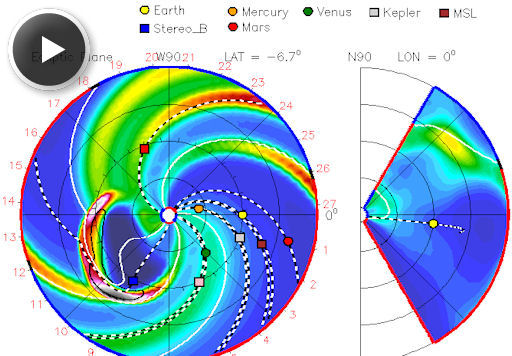INCREDIBLE SUNSPOT AR1429: Big sunspot AR1429, the source of so many strong flares and geomagnetic storms earlier this month, is still erupting. The active region produced a significant coronal mass ejection on March 24th at 00:39 UT: movie. Because of the sunspot's location on the farside of the sun, this particular CME will not hit Earth. An animated forecast track prepared by analysts at the Goddard Space Weather Lab shows the trajectory of the expanding cloud:
The leading edge of the CME is expected to arrive at the STEREO-B spacecraft on March 25th at 13:08 UT (+/- 7 hours). None of the inner planets will be affected.
Since March began, sunspot AR1429 has propelled CMEs into every corner of the solar system, stirring up stormy space weather around every planet and spacecraft. If the sunspot remains active for another week or so, it will turn back toward Earth for a new round of geoeffective eruptions. Stay tuned.

![]()
Solar wind
speed: 386.4 km/sec
density: 2.7 protons/cm3
explanation | more data
Updated: Today at 1636 UT
![]()
X-ray Solar Flares
6-hr max: B9 1157 UT Mar25
24-hr: C3 0028 UT Mar25
explanation | more data
Updated: Today at: 1600 UT
![]()
![]()
![]()
Daily Sun: 25 Mar 12
![]()
![]()
Sunspot 1445 is crackling with C-class solar flares. Credit: SDO/HMI
![]()
![]()
![]()
Sunspot number: 65
What is the sunspot number?
Updated 24 Mar 2012
Spotless Days
Current Stretch: 0 days
2012 total: 0 days (0%)
2011 total: 2 days (<1%)
2010 total: 51 days (14%)
2009 total: 260 days (71%)
Since 2004: 821 days
Typical Solar Min: 486 days
Updated 24 Mar 2012
The Radio Sun
10.7 cm flux: 103 sfu
explanation | more data
Updated 24 Mar 2012
![]()
![]()
![]()
Current Auroral Oval:
![]()
Switch to: Europe, USA, New Zealand, Antarctica
Credit: NOAA/POES
![]()
![]()
![]()
Planetary K-index
Now: Kp= 2 quiet
24-hr max: Kp= 2 quiet
explanation | more data
![]()
Interplanetary Mag. Field
Btotal: 3.3 nT
Bz: 1.7 nT north
explanation | more data
Updated: Today at 1637 UT
![]()
![]()
![]()
Coronal Holes: 25 Mar 12
![]()
![]()
There are no large coronal holes on the Earthside of the sun. Credit: SDO/AIA.





